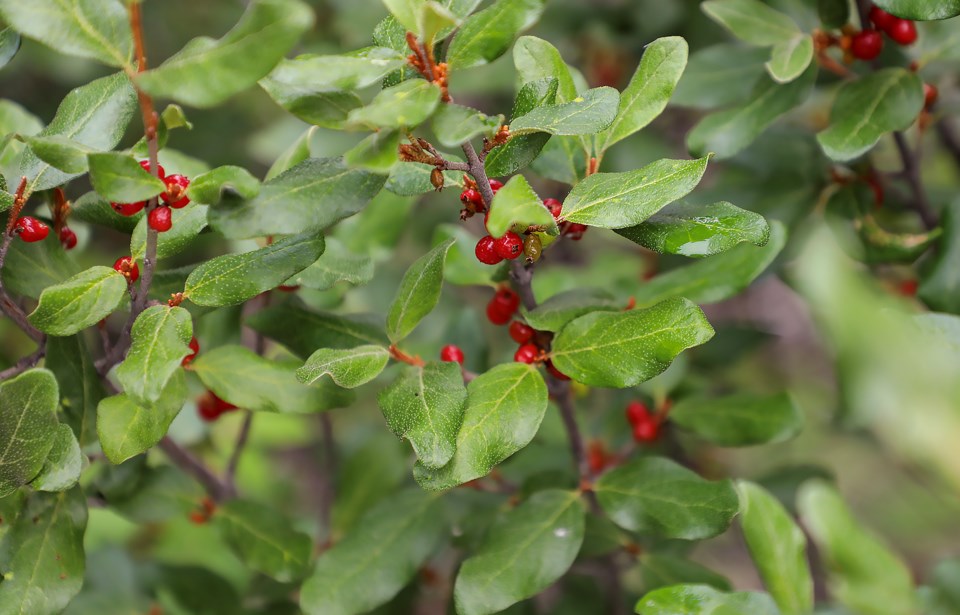BANFF – Bears are roaming far and wide in search of buffaloberries – their prime food source in Banff National Park and Kananaskis Country – but so far the crop is looking spotty.
The buffaloberry crop size varies from year to year and Nick de Ruyter, program director for Bow Valley WildSmart, said while berries are starting to ripen in the Bow Valley “it’s definitely very spotty.”
“There are berries in the Bow Valley but it’s not looking like it’s going to be a good crop anywhere, nothing substantial at least, so that’s definitely a shame,” he said.
“It’s even thinner down in Kananaskis Country at this time.”
Parks Canada issued an advisory for Banff National Park on July 17 for buffaloberry season, which typically runs from mid-July until September.
Also known as shepherdia, the fruit-bearing shrubs are a critical high-calorie food source for bears and their single most important food source in the mountain parks.
Focused with their heads down, grizzly bears can eat up to 100,000 buffaloberries a day and large male grizzlies can devour double that.
They can also eat for up to 20 hours a day later in the season as they enter hyperphagia, a period of intense eating where bears forage around the clock to put on fat for winter’s hibernation.
The berries – which are bright red, yellow and orange – are often found in sunny areas along trails, roads, campgrounds and recreation areas as well as the edges of meadows, rivers and streams.
Because bears are so focused on feeding right now, and can easily be surprised, de Ruyter said it is vital that hikers, mountain bikers and runners make lots of noise out on the trails.
“Bears are focused on eating, they have their heads down, they’re not paying attention, they’re not listening, so let’s do our best to give them space they need to feed undisturbed and forage,” de Ruyter said.
“Even if you’re yelling at the top of your lungs, they may not react because they’re so focused on eating, and because the berry crop is poor, it’s going to put a little bit more stress on the bears so they might act a little bit more protective of the limited food source.”
Because berry bushes are also found along trails, de Ruyter said people might be more likely to bump into bears at this time of year, “which is evident from the bluff charges and bear spray deployments and warnings and closures.”
“People are running into them a lot because along trails is where the berries are,” he said.
Alberta Parks issued a closure July 28 at Rummel Lake and surrounding area after the day before a grizzly bear with cubs charged a hiker, who ended up deploying his bear spray.
There is also a warning at Elbow River Provincial Recreation Area for the Sulphur Springs Trail after a black bear bluff charged hikers, who were with their dogs on-leash.
On Aug. 1, a grizzly bear with cubs forced closure of the Chester Lake area including trails leading to Chester Lake. The High Rockies Trail is not affected by this closure.
De Ruyter reiterated how important it is to make lots of noise and carry bear spray.
He said runners or mountain bikers, which go at a faster speed than hikers, can easily surprise bears focused on eating berries on the side of the trail.
He said he’s heard reports that bears are being sprayed prematurely and the “bear maybe didn’t deserve it.”
“If there’s a bear on the trail, turn around or just wait it out, because you need to go back to the car or the parking lot is not a reason to spray a bear. Bear spray is the most effective deterrent against bears, but it’s not like a convenience tool. It’s meant to save your life,” he said.
“Give the bear the chance to move off and do the right thing and then if they don’t and they charge at you or run at you and you feel like your life is in danger, by all means use you bear spray, but don’t just use it to scare bears off the trail because you potentially snuck up on them or surprised them.”
To reduce your risk:
- Make noise while on trails.
- Travel in tight groups.
- Trail running and cycling place you at much higher risk. Travel very slowly. Do not wear earbuds. • Carry bear spray, ensure it is accessible, and know how to use it.
- Watch for fresh bear signs such as scat. Be especially careful near berry patches. • If you see a bear, stay calm, back away slowly and leave the area. Never run.
If you see a bear in Banff National Park, report it to Banff Dispatch at 403-762-1470. For bear sightings in Kananaskis Country call 403-591-7755.




